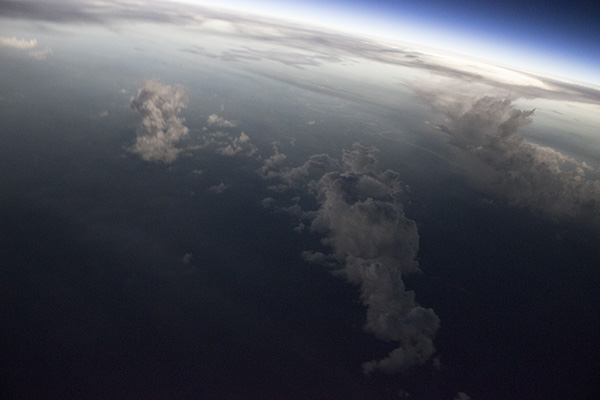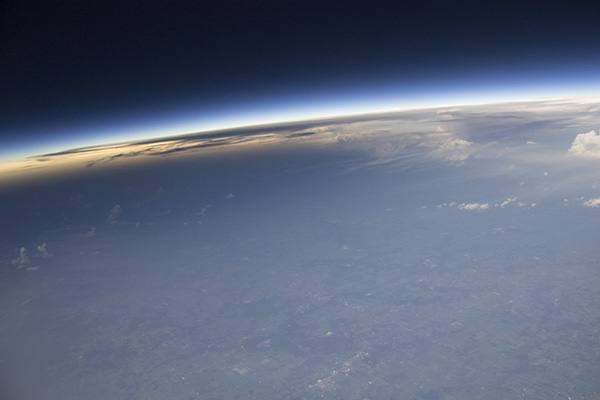A group of Chicago-based citizen scientists launched an enormous balloon into the Southern Illinois sky last week, capturing high-definition images from 90,000 feet in the air during the historic solar eclipse.
"The mission was a success!" Daniel Meyer, one of the balloon’s builders, proclaimed over the phone on his drive back to the city. Meyer was part of the eight-person Artemis 1 team that drew members from South Side Hackerspace: Chicago, a Bridgeport-based group for creative people using technology in new ways, and the smaller Remote Astronauts Club. The team launched the balloon as part of NASA’s Space Grant Ballooning Project, which sent up more than 50 high-altitude balloons across the country to capture images of last Monday’s solar eclipse.
The team drove five vehicles full of equipment to Southern Illinois on Sunday night, launched the 16-foot-tall weather balloon into the sky on Monday morning, retrieved it from a tree on Monday evening, and then returned Tuesday with over 5,000 photos and an hours-long 360-degree video of the balloon's journey. (Team member Matthew Wendeln kindly edited it down to a few minutes for Chicago, embedded below.) “It was mindblowing when we saw the images,” Meyer said. “They did not look like any images we’d ever seen before.”
Below, Meyer tells us more about the project, the beautiful images they captured, and the important ways in which citizen science inform scientific research.
Describe this enormous balloon and why you guys wanted to launch it during the eclipse.
So it’s a really large, high-altitude weather balloon with Styrofoam coolers hanging off the bottom, filled with all of this radio transmission gear, tracking gear, and then most importantly, the cameras recording and transmitting the surroundings. The purpose was to capture this bizarre visual event that most people don’t get to see in their lifetime, from an altitude that only astronauts go through. It's an eye in the sky at 90,000 feet. We also wanted hook our live video feed up with the NASA website so people across the country could experience this with us.
What's important or interesting about the photos you captured?
They're something you haven’t seen very much of before. We’re close enough to get really good detail because we're not in orbit like a satellite, which is pretty far away, and then we’re way higher than an airplane. So our balloon is operating in an airspace that not many human vehicles reach. Even people from the space station don't get to see this vantage point very often.

What went into planning and preparing for this project?
About three or four months. We purchased the last remaining kit from NASA and then built it in only two months—a lot quicker than other teams, some of whom had been working on this for more than two years. So we knew it was kind of a risky project. We did a few test launches over three months. The whole project cost close to $10,000. It was partially self-funded and partially crowdfunded through generosity.com.
How does a high-altitude balloon work?
You fill the balloon with enough helium that it ascends at a certain rate and a certain speed, and then it pops at an exact altitude. We launched pretty early so that the balloon would be at 90,000 feet during the eclipse's totality. And then at 102,000 feet [around 2:55 on the video], the balloon bursts. So it tumbles back to earth very wildly for a while and then the atmosphere starts to return, the parachute opens, and it begins to descend at a slower rate. We have online tracking gear that tells us the latitude and longitude of the balloon and tracks it live, which helps us to chase and recover the balloon when it gets close to the ground.

On the way down, the balloon got caught in a tree. Did that make recovery difficult for you guys?
Actually, it was ideal. What if it landed on a highway and everyone ran over it? On our last test mission it landed in Lake Michigan. Is it going to sink? Is water going to get into all our equipment? On Monday, we just called a tree service and paid them to get it down for us, because cutting it down or trying to climb could have damaged the equipment.
Anything in particular we should look for in the images?
So in the 360-degree video, one of the coolest things that we saw was a 360-degree sunset around the entire horizon during totality. [That's around 3:12 in the video below.] It's so weird-looking and something I've never seen. Then in the still images, look for the shadow of the moon being projected on the earth. You’ll see a dot—a pretty big projection of a dot on the earth that’s a shadow, and then light around it on either side.

How significant was the participation of citizen scientists in terms of the way this eclipse was captured and researched?
The participation of citizen scientists allows NASA to collect larger amounts of data across the country than they could do alone. It sounds kind of simple when I say it, but it’s the democratization of science: regular people doing something that used to be only the realm of NASA. It's also lower-cost, which is important when there are so many budget constraints on our national science projects. Citizen science is the future of science, period.



